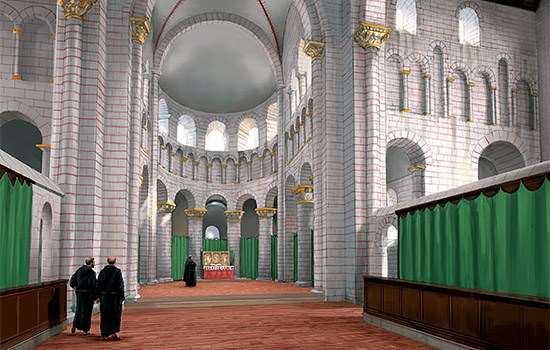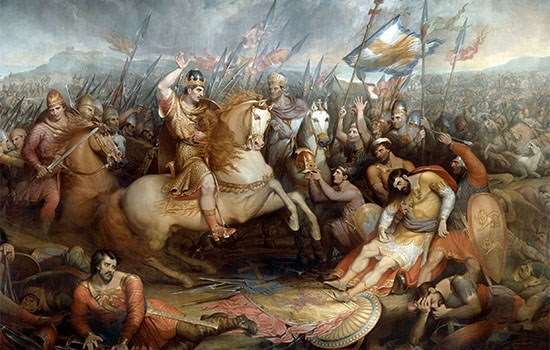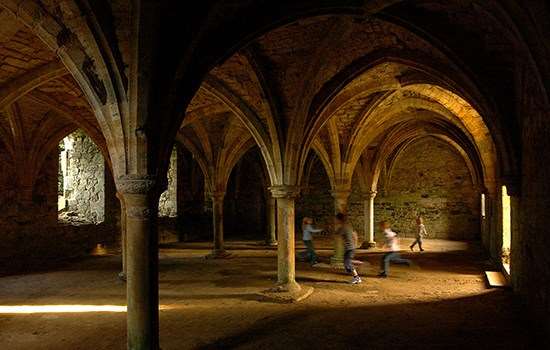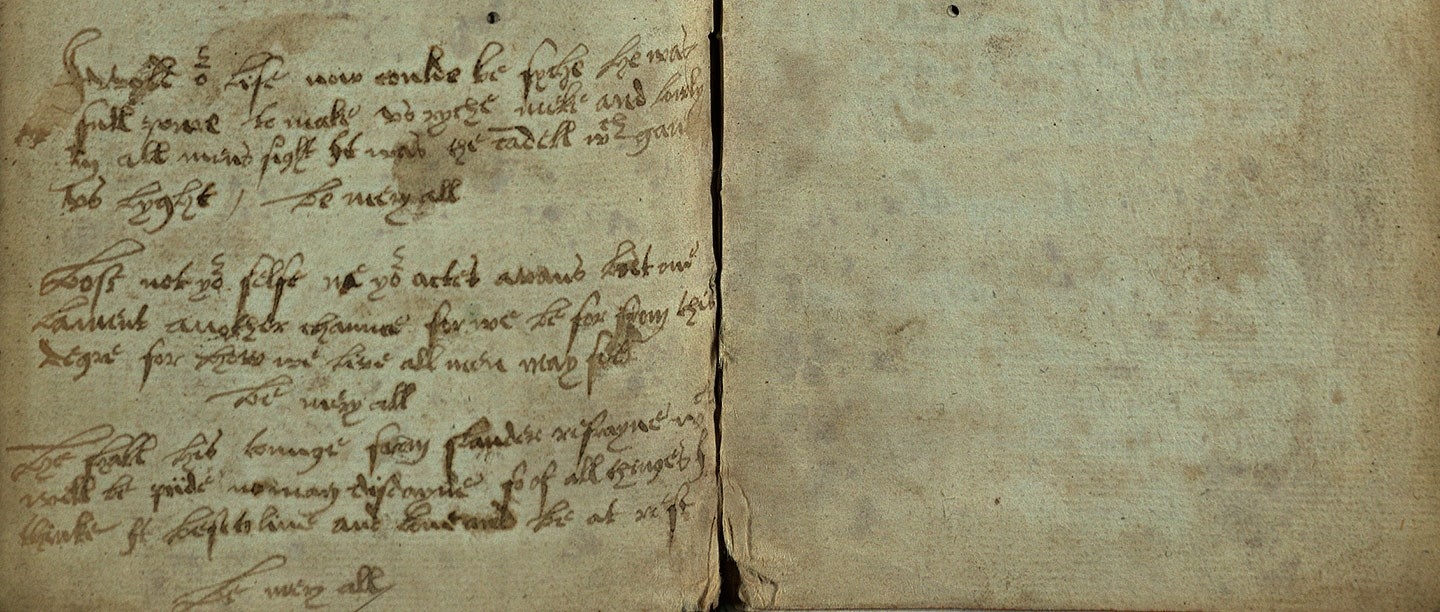Q: Michael, how did you discover the carol?
Michael: One of the great things about being an English Heritage historian is that you never know quite where your research will take you. I stumbled across it while I was examining a late medieval breviary (or prayer book) from Battle Abbey in the Wren Library at Trinity College, Cambridge, looking for evidence of the spiritual life of the monastery. The breviary – the only liturgical book to survive from the monastery – dates to about 1500 and contains the texts for the services celebrated by the Battle monks throughout the year.
Monks were great doodlers, and often filled the blank margins and endpages of liturgical books with annotations, jottings, even humorous drawings. This manuscript is no exception. Added to the blank leaves at the back are recipes for remedies to treat gastric complaints, a short poem about the deaths of three of Battle’s abbots, and then – most significantly of all – two versions of a carol.
Although the carol was noted in the 1930s by Montague Rhodes (M.R.) James – who is best known today for his ghost stories but was a distinguished scholar of medieval manuscripts – the insights the carol provides about religious life at Battle Abbey have never been investigated before.
Q: What exactly is a carol?
Michael: The origin of the term carol has been much debated but it probably relates to the French carole, a ring dance. Indeed, Chaucer used 'carole' to mean a dance with a song. However, by the early 15th century it had come to mean a song with or without a dance, and by the early 16th century, when our Battle monk was jotting in the back of his service book, the ordinary meaning of carol was a song.
Then as now, carols are properly defined by their form, not their subject matter. To qualify as a carol, a song must have an opening chorus which is repeated after each verse.
Q: Were medieval carols just sung at Christmas, like ours today?
Michael: The association between carols and Christmas was already developing in the Middle Ages – of the 500 or so English medieval carols that survive, over half have Christmas as their subject. Despite this, carols could be on any subject, including the Trinity, individual saints, Purgatory, and – like the Battle carol – the life of Christ. There are also secular carols, some with bawdy texts.
Q: Were monks particularly associated with carols?
Michael: Franciscan friars were especially associated with using songs and carols in the native language (rather than Latin) in their preaching and evangelising. Nevertheless, other religious orders also showed an interest in carols. They can be found in late medieval manuscripts from several other English Heritage monasteries, including Bury St Edmunds, Suffolk, and Haughmond Abbey, Shropshire.
Q: Would the monks have sung this carol in church?
Christopher: No, carols weren’t sung in medieval church services, which were celebrated almost entirely in Latin plainsong. This carol is written in English. Even when carols’ subject matter was religious, they were intended for performance in a secular context. At Battle Abbey the most likely performance venue would have been the great hall in the abbot’s lodging, where the abbot would entertain guests and celebrate feasts.
By the 15th century carols could be quite elaborate both poetically and musically, and so suitable for formal entertainment. The Battle carol’s burden (or chorus) instructs the hearers to ‘be mery’, so it would seem very suitable for performance on a feast day.
Q: What is the carol about?
Michael: It’s an example of a form of piety that focused on the life and sufferings of Christ, and was pioneered by the new religious orders of the late 11th and early 12th centuries, such as the Cistercians and Carthusians. Later, this type of piety was popularised by authors like the hermit Richard Rolle (d.1349) and Nicholas Love (d.1424), prior of Mount Grace, a Carthusian monastery in Yorkshire. They emphasised Christ’s humanity, and encouraged their readers to empathise with His experiences and sufferings. To this end, the first verse of the Battle carol emphasises Christ’s poverty and humble living, and His ‘biter’ death for mankind.
This form of piety was intended to help people repent and adopt a more Christ-like way of living. So the carol exhorts us to ‘Care not to[o] myche [much] for worl[d]y pleasure / Lest hereafter ye lose a better tresure’. It highlights mankind’s failure to live according to Christ’s example, ‘For we be far from this degre[e]’. The chorus urges the singers to be ‘folowers of Crystes worde’.
The carol is clear evidence that the Battle monks were very much part of the thriving devotional culture of Catholic England – a culture brutally cut short by the Reformation, which extinguished 500 years of religious life at Battle.
Q: Christopher, what were the challenges of setting this carol to music?
Christopher: As a musician specialising in medieval music, I’m used to performing music written long ago, in unfamiliar notations, for people who didn’t necessarily use written music in the same way that we do. But the task I faced in bringing this carol to life was altogether greater: I was presented with a text obviously intended for singing but with no musical indications to guide the performer.
So I had a long and fascinating interpretative journey as I gradually became familiar with the carol and searched for indications as to how it might be performed.
Q: How did you make a start?
Christopher: The observation that this was music for a festive occasion, in an elite and probably quite formal context, was a key starting point for me. Then I studied the text for further clues.
The carol has six verses of four lines each, with a two-line burden sung at the beginning and after each verse. This pattern is typical of medieval carols, but a distinctive feature of this one is that the final burden has slightly different words. Although the carol was copied into the manuscript in the early 16th century, it’s likely that it was originally written somewhat earlier. So I chose to imagine a performance date towards the end of the 15th century.
The kind of music required was therefore clear. It should be joyful or celebratory in tone, written in a fairly elaborate 15th-century style, but retaining the directness of expression typical of carols.
Given new words to set to music, a medieval musician would have had two choices: to compose new music, or to adapt an existing composition to fit. For me, the advantages of the second option were obvious. It would be much more likely to result in a convincingly medieval sound than anything I might compose from scratch, to which I would undoubtedly bring unconscious stylistic influences of my own.
Q: So which music did you choose to work with?
Christopher: I made a survey of 15th-century carols, and after some trials settled on an anonymous carol in the ‘Ritson’ manuscript, now in the British Library, where it is set to the text ‘Y pray yeu alle with on thort’ (‘I pray you all with one thought’). The similar beginning of the Battle carol, ‘Be mery all with one accorde’, promised a good match. There were other similarities between the texts – the same number of lines in each stanza, and comparable patterns of accentuation. Conveniently the Ritson carol also provided two settings of the burden, one of them suitable for our final refrain.
I was also attracted to the music, which began each line quite plainly, allowing the text to be declaimed clearly, before becoming more elaborate, with florid runs of notes and sophisticated cross-rhythms.
Q: How did you adapt the music for our carol?
Christopher: First, it had to be transcribed from the mensural notation (the late medieval system of writing music) of its source into modern notation, so that its note values (or durations) agreed with modern conventions. I also had to decide what to do about the adjustments of pitch at cadences (the ends of musical phrases) which were often performed but not written down.
Fitting the words to the music was a particular challenge. The Battle carol has a regular pattern of four accents per line, but while most lines have eight syllables in an iambic rhythm (da DUM da DUM da DUM da DUM), some have up to 11 syllables to be either fitted to the notes or elided.
At this stage I also had to think about pronunciation. Between about 1400 and 1700 English pronunciation changed greatly, in a process known as the Great Vowel Shift. I had to consider how the text might have been read in the south of England in the late 15th century to understand how a singer might fit each syllable to the music.
Q: How did you decide on the singer and instruments?
Christopher: Medieval scores rarely specify instruments for their performance, and it seems that there was considerable flexibility in practice. In a monastery, a male singer seemed most appropriate, so I chose to have a countertenor sing the melody.
Since there is archaeological evidence of musical instruments at the abbey, it made sense to have an instrumental accompaniment. A vielle (a medieval viol) was well suited to the tenor notes of the accompaniment, and a harp provided a versatile addition, capable of supporting the other parts as well as playing independently.
Q: Finally, how does it feel to hear the carol being performed?
Michael: It was one thing to find this carol and write it down – completely different to hear it for the first time in 500 years. The words take on a different meaning when you hear them sung. You also get a greater sense of the emotional impact this carol would have had. At the end, you go from being a ‘follower’ of Christ’s word to a ‘doer’ – so singing the carol leads to a transformation within you.
Christopher: After so much work it was a great pleasure to hand over to three excellent performers and to hear the carol for the first time. This, of course, was an occasion for new creativity, as the trio embellished the music and added their own subtleties of expression.
For me it was a chance to appreciate more fully the aesthetic qualities of the carol and to reflect on its joyful but challenging words, which are moralising but free of modern sentimentality.
I hope visitors to Battle Abbey will also take pleasure in this music and gain insights into the culture from which it came.
Visitors to the abbey can hear recordings of the kinds of music we know would have been sung at Battle, including the carol. You can listen to an extract from the carol and read its words below.
Visit Battle AbbeyListen to an extract
Find out more about Battle Abbey
-

History of Battle Abbey
Read an in-depth history of the abbey founded by William the Conqueror after the Battle of Hastings, from its foundation to its suppression and after.
-

Atoning for the Bloodshed: the foundation of Battle Abbey
Battle Abbey was a memorial to William’s great victory – but it was also an act of penance. Find out why this great abbey was founded.
-

Visit Battle Abbey and the 1066 Battlefield
See where the Battle of Hastings was fought, explore the majestic abbey remains, and and visit our brand new exhibition to find out what life was like for the medieval monks.

